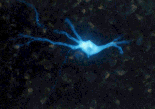| Sponsored by Wake Forest University School of Medicine and National Families in Action | |||
| Glossary - C | |||
| This glossary comes from False Messengers: How Addictive Drugs Change the Brain, by David Friedman, PhD, and Sue Rusche, Harwood Academic Publishers, Amsterdam, The Netherlands, 1999. A
| B | C | D
| E | F
| G | H
| I |
|
|||
| C Caffeine A mild stimulant, the most widely used drug in the world. Cannabinoid receptor The receptor in the brain that recognizes THC, the active ingredient in marijuana. Marijuana exerts its psychoactive effects via this receptor. Cannabis The botanical name for the plant from which marijuana comes. Capillaries The smallest blood vessels. Oxygen and nutrients leave the bloodstream through capillaries to get into the body. Gases from the alveoli enter the bloodstream through capillaries in the lungs. Cell body The central structure of a neuron, which contains all of the molecular parts that keep the cell alive, generate new parts, and repair or destroy existing parts. Cell membrane The outside covering, or "skin" or a cell. Receptors and ion channels are embedded in it. Cellular metabolism The production of energy and new materials in a cell. Central nervous system The brain and spinal cord. Cerebral cortex The large, deeply folded outer layers of the brain that make our heads so big. The cortex carries out complex perceptual, cognitive, and motor tasks. "China white" A designer drug" that was an opiate derivative. Some batches contained a neurotoxin called MPTP, which killed neurons that make dopamine, producing symptoms similar to Parkinson's disease. Cholinergic The adjective derived from acetylcholine. A neuron that contains acetylcholine is a cholinergic neuron. Circuits A group of cortical fields or nuclei that are linked together by their axons to perform a specific brain function. Core components or circuits are constantly in touch with each other, whereas other components can be brought in as the need arises.
|
|
Classical
conditioning The form of implicit, unconscious learning in which
a neutral stimulus becomes associated with a significant stimulus through
repeated pairing of the two.
Cocaine A highly addictive stimulant drug derived from the cocoa plant that produces profound feelings of pleasure. See Crack. Codeine A natural opioid compound that is a relatively weak, but still effective, opiate analgesic. It has also been used to treat other problems (e.g., to relieve coughing). Cognitive functions Higher brain functions involving the manipulation of information from the senses and from memory. They often require awareness and judgment, and they enable us to know and to analyze problems and plan solutions -- in short, to think. Cortical field A large aggregation of millions of nerve cells in a circumscribed region of the cerebral cortex, which together carry out a specific function, receive connections from the same places, and have a common structural arrangement. There are many dozens of such fields in the cerebral cortex. Elsewhere in the brain such groups are called nuclei. Crack A chemically altered form of cocaine that is smoked. Craving Hunger for drugs. It is caused by drug-induced changes that occur in the brain with the development of addiction and arises from a need of the brain to maintain a state of homeostasis that includes the presence of the drug. Cues Formerly neutral stimuli that acquire the ability to elicit drug-craving through classical condition. Cues are also called triggers.
|
|
| Home | For Journalists | For the States | Science Update | Links | Glossary | About |
Last Revision
info@addictionstudies.org

